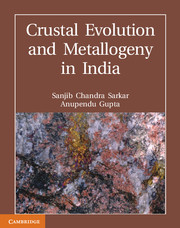Book contents
- Frontmatter
- Dedication
- Contents
- List of Figures
- List of Tables
- List of Plates
- Preface
- Chapter 1 Southern India
- Chapter 2 Central India
- Chapter 3 Eastern Ghat Belt
- Chapter 4 Eastern India
- Chapter 5 North-East India
- Chapter 6 Western India
- Chapter 7 The Himalaya
- Chapter 8 Crustal Evolution and Metallogeny in India: A Brief Review in the Context of the World Scenario
- References
- Index
- Plate Section
Chapter 8 - Crustal Evolution and Metallogeny in India: A Brief Review in the Context of the World Scenario
Published online by Cambridge University Press: 05 February 2014
- Frontmatter
- Dedication
- Contents
- List of Figures
- List of Tables
- List of Plates
- Preface
- Chapter 1 Southern India
- Chapter 2 Central India
- Chapter 3 Eastern Ghat Belt
- Chapter 4 Eastern India
- Chapter 5 North-East India
- Chapter 6 Western India
- Chapter 7 The Himalaya
- Chapter 8 Crustal Evolution and Metallogeny in India: A Brief Review in the Context of the World Scenario
- References
- Index
- Plate Section
Summary
An Outline of the World Scenario
Introduction
The Earth's crust, as we see it, is the result of the geodynamic and geochemical activities that took place throughout the geological past in the crust–mantle system, added with the effects of evolution in the atmosphere, hydrosphere and biosphere. It is needless to mention that some of the crustal material must have been lost through erosion and tectonism (subduction). Moreover, the larger part of the crust is not accessible to direct observation. There the authors were obliged to take to indirect means, the results of which are fraught with a greater amount of uncertainty in many cases. In the present chapter, the global picture of crustal evolution in terms of the above is outlined, mentioning alongside the metallogeny which is now better understood in the above context. Projected on this background, a brief review of the salient aspects of crustal evolution and metallogeny in India is done, pointing out where these conform to the overall global picture and where they do not. This is likely to be of some use while making generalisations on the Earth's events, at the same time drawing attention of the potential researchers in the subject, particularly to the aspects, which deserve more attention in future.
- Type
- Chapter
- Information
- Crustal Evolution and Metallogeny in India , pp. 717 - 740Publisher: Cambridge University PressPrint publication year: 2012



